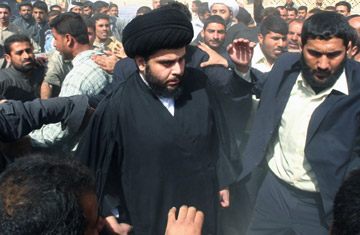
Mehdi Army members escort Shi'ite cleric Moqtada al-Sadr during his visit to the holy city of Najaf, Iraq, Feb. 27, 2006.
When the envelope was finally opened, Moqtada al-Sadr's message couldn't have been tamer. Having sent out sealed envelopes to Shi'ite mosques around Iraq containing his verdict on the future of the cease-fire observed by his Medhi Army, Iraq waited on tenterhooks for the message to be read at Friday prayers. "I'm extending the freeze of army activity," al-Sadr's statement read, ordering his militia to remain standing down until mid-August, when presumably the cleric will reconsider. Despite pressure from within his movement's ranks to end the cease-fire that, they complain, has been used by U.S. forces and al-Sadr's Shi'ite rivals to go after the organization, Friday's message hardly mentioned his many enemies in Iraq.
Many in Iraq had feared that Sadr would nix the cease-fire, a move likely to set off another round of sectarian violence and reverse many of the gains of the U.S. troop surge. But U.S. officials had expected that Sadr would maintain the pause, which has been a major factor in bringing down the overall level of violence in Iraq. Sadr had sent some signals to the Americans suggesting he was likely to extend the cease-fire. And U.S. officials, such as Gen. David Petraeus and Ambassador Ryan Crocker, believe that the Shi'ite firebrand may be changing his ways.
"We have seen a shift in Sadr's strategy, I believe," said Gen. Raymond Odierno, the ground commander for U.S. forces in Iraq. "He has talked more and more about moving toward a more humanitarian movement, a political movement more like his father had, and away from a more lethal, militia-type movement."
The Sadr movement has, of course, long been involved in social and political activism in addition to militia violence. Its activists can be found doing everything from from holding seats in parliament to offering cut-rate propane in poor Shi'ite neighborhoods. That the Sadrists might choose to emphasize some of these activities over armed confrontation is quite plausible, but Moqtada al-Sadr is notoriously unpredictable, and the thinking behind his moves is often unclear. Sadr could just as easily be simply biding his time until surge troops leave in July.
Yet Sadr learned in 2004, at great cost to his organization, that open confrontation with U.S. forces is a bad idea. The Mahdi Army fared poorly against U.S. troops in two separate uprisings in southern Iraq that year. In the years that followed, Sadr's militia fighters kept up a kind of shadow war against U.S. troops, staging sporadic guerrilla attacks. But the Mahdi Army has largely avoided confronting U.S. forces for years, and the cease-fire Sadr announced unexpectedly six months ago was not directed at the Americans as much as it was aimed at halting fighting between Sadr's followers and members of the rival Shi'ite Supreme Islamic Iraqi Council (SIIC) and its Badr militia. Intra-Shi'ite fighting threatened al-Sadr's popularity, and it was in his interests to tamp things down. But the Sadrists and SIIC are still vying for control in much of southern Iraq, and their conflict is likely to flare up again. Al-Sadr may be calculating that it will be easier to fight his rivals in the summer, when there will be fewer American forces to stand in the way.
Extending the cease-fire also allows Sadr to distance himself from the thuggish violence of members of his militia, while keeping the organization intact despite U.S. and Iraqi government demands that he disband it.
So, while Friday's announcement was greeted with relief, most in Baghdad are still left wondering about Sadr's intentions and plans. "I'm always real modest about analyzing our capacity to analyze," said U.S. Ambassador Ryan Crocker. "We don't see very much of the Sadrists. And the those we do see I think definitely represent the clear political trend; they don't much like militias either. But what insight do we actually have into a very, very complex phenomenon? Not much."
